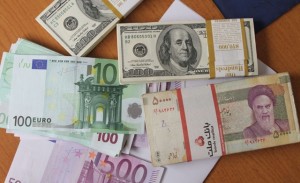 The story of Iran�s hyperinflation was not a hoax, but instead reflected a deep misunderstanding of Iran�s economic situation. Sensational stories of economic collapse in Iran appeared in the blogosphere and in the mainstream press � and they simply were not true. Since accurately understanding the impact of sanctions is critical for setting US policy, what lessons can we learn from this episode?
The story of Iran�s hyperinflation was not a hoax, but instead reflected a deep misunderstanding of Iran�s economic situation. Sensational stories of economic collapse in Iran appeared in the blogosphere and in the mainstream press � and they simply were not true. Since accurately understanding the impact of sanctions is critical for setting US policy, what lessons can we learn from this episode?In late September 2012, Iran�s currency took a dive, falling by about 50% in two weeks. This was seen as a definitive sign that sanctions against Iran were bearing fruit, that Iran�s economy was on the verge of collapse and that the West would face a humbled Iranian leadership in the nuclear standoff. The key to the story was a�prediction�published on the website of the conservative Cato Institute that the devaluation would cause prices in Iran to rise by 70% per month, doubling every 38 days, which is hyperinflation.
The prediction was based on faulty analysis, and it ignored the simple fact that the same Iranian government that prints the rial also earns all the foreign exchange. But �it nevertheless became the standard story. Forbes likened the crisis to a �weapon of mass destruction� that would send Iran �the way of Weimar,� and the�Bloomberg headline read, �Turning Iran�s Currency Crisis Into a Revolution.� The�Boston Globe�was even more specific: �As Iran�s economy crashes, sanctions could yet bear fruit.� The�Financial Times, the�New York Times,�The Wall Street Journal�and the�Washington Post�all reported the hyperinflation story in print or online.
Three months after the rial's sharp devaluation, we can be certain that claims about hyperinflation were unfounded. For the first two months, the Consumer Price Index (CPI) rose by 4.5% each month, but in the third month the rate of�increase slowed�to 2.5%. At this rate, inflation for the year will likely reach above 30% � but that is still a far cry from prices doubling every 38 days.
Does the CPI reflect the true rate of inflation? If you don�t believe it, take a cab ride in Tehran. (If you can�t do that, you'll have to take my word for it.) A month ago I took a 45-minute cab ride to the airport from the polite driver who often picks me up at 2 a.m. At the airport, he said apologetically that the fare had increased by 50,000 rials since my last trip in July � a 20% increase in 5 months. This is not surprising since, although some prices have doubled or tripled since last summer, prices for many basic goods � like energy, bread and chicken � have stayed the same.
Had the media asked questions about the assumptions behind the hyperinflation theory, instead of eagerly reporting it, they would have noticed the lack of a connection between devaluation, printing of money and inflation. As I�explained�at�the time, since the government controls nearly the entire supply of foreign exchange, it doesn't need to print and buy money to pay for its own expenses, and to control prices, it can decide to sell some of it at a much lower rate. The flawed analysis was taken at face value because it corroborated conventional wisdom about Iran�s economy. Even when it had been growing at a robust 5% per year for about a decade, thanks to rising oil prices, experts in Washington routinely described it as on the brink of collapse.
Sanctions are the pillar of US and European policy toward Iran, and guessing incorrectly about their impact is costly. In the last few weeks before the US presidential election, candidate Obama might have considered setting a �red line� in the nuclear dispute with Iran, such as an outright ban on enrichment on Iranian soil, if he believed that the sanctions were bringing Iran to its knees. Fortunately, he did not, thus keeping his options open in negotiating a peaceful settlement with Iran.
By Al-Monitor
The Iran Project is not responsible for the content of quoted articles.










